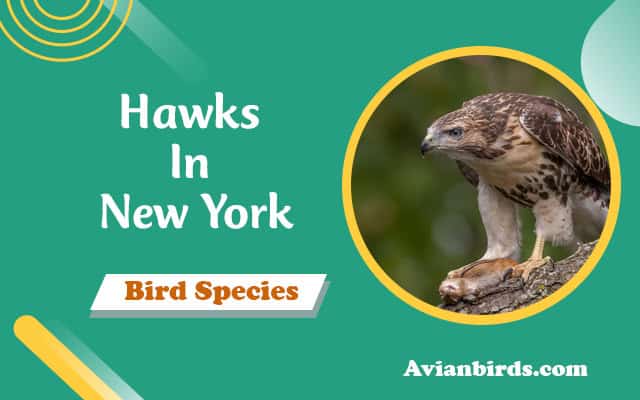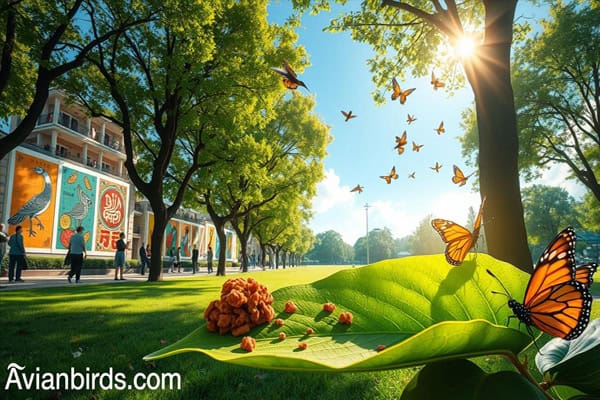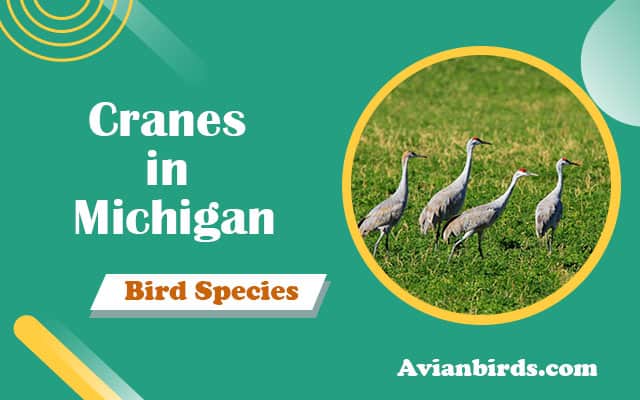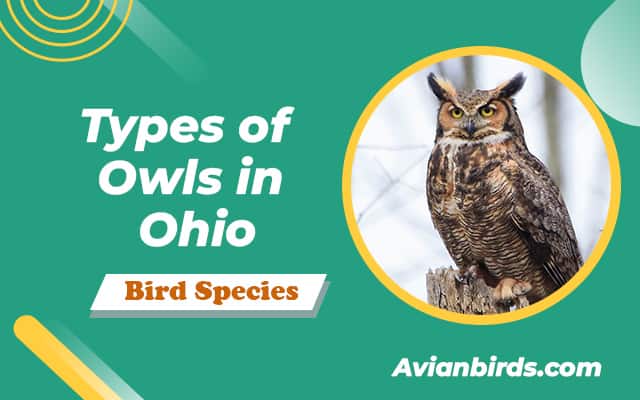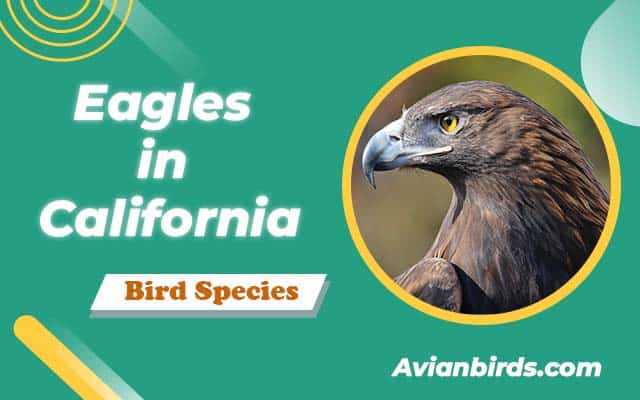5 Types of Hawks in New York And Where To Find Them
Did you know the red-tailed hawks in New York can live up to 30 years and weigh 3.8 pounds? This bird is just one of many hawks in New York. We’ll learn about their characteristics, habitats, and the best spots for watching them.
New York’s varied habitats make birding exciting, from cities to forests. Whether you’re new or experienced, knowing about these hawks is important. It helps us appreciate their role in our ecosystem.
Introduction to Hawks in New York
New York is known for its vibrant urban life. Yet, it also has a hidden treasure: a wide variety of hawks. We will explore how these birds fit into New York’s birdlife and ecosystems.
Hawks can be found in New York’s forests and city parks. They have adapted well to different places. This shows their strength and importance in our environment.
As we learn more about hawks’ introduction, we find many places to see them. Birdwatchers can watch these amazing birds in action. Hawk migration in spring and fall is a special time to see them.
Protecting our urban ecosystems is important. This helps hawks and all the birds in New York. We hope for a bright future for these birds and their role in New York’s nature.
Understanding Hawks
Hawks are fascinating birds with unique traits. They belong to the family Accipitridae. Their sharp talons and beaks help them hunt, and their excellent eyesight lets them spot prey from far away.
When we watch hawks, we see how they hunt in different ways. They soar over open fields or sneak through woods, which shows their adaptability and skill.
Hawks are known for their monogamous pair bonds. Males and females mate for life, showing their love through courtship. This bond is key during the nesting season, which lasts from February to August in cities like New York City.
In 2019, 15 pairs of Red-tailed Hawks were nested on human-made structures in the city. This shows how they adapt to urban environments.
Parental investment is a big part of Hawk’s life. The female hawk is usually bigger than the male. This is because she lays eggs and takes care of the young.
In 2019, 71 fledglings were reported from 42 nests. This shows the importance of protecting their habitats. Hawks are not just hunters; they are vital to our ecosystems.
Hawks of New York
New York is home to many hawk species. This allows bird lovers and casual watchers to see these amazing birds. We have at least eight hawk species here, like the Red-Tailed Hawk and the Northern Harrier.
Each hawk has its own look, where it likes to live, and how it finds food. This makes our local raptors very interesting.
Overview of Hawk Species
The Red-Tailed Hawk is excellent at flying over open fields, and the northern harrier is good at flying low over grasslands. We see many different behaviors and places where they live.
Some of the most notable hawks in our area are:
- Red-Tailed Hawk
- Red-Shouldered Hawk
- Northern Harrier
- Cooper’s Hawk
- Sharp-Shinned Hawk
Our hawks migrate twice a year: from March to May and again from late August to November. Places like Chestnut Ridge and Hook Mountain State Park are great for watching them.
At these spots, people count thousands of hawks. This helps us learn more about these birds and how to protect them.
Importance of Hawks
Hawks are very important in our ecosystem. They help control the number of rodents and birds and tell us about the health of their habitats.
Because of this, we need to protect them. Working with groups like the Hawk Migration Association of America is key. It helps us keep these birds safe in our growing cities.
1. Red-Tailed Hawk
The Red-Tailed Hawk is the most common in New York. It is known for its strong build and rusty red tail. Bird watchers and nature lovers need to know how to spot it.

Description and Identification
Spotting Red-Tailed Hawks is more than just looking at their tails. They have broad wings and a sturdy body. Their feathers can change a lot, making color hard to use for spotting.
There are dark and light morphs, with browns and pale colors. A dark band on their belly is a key clue. This helps us tell them apart from other hawks.
Best Places to Spot Red-Tailed Hawks
Finding Red-Tailed Hawks can be exciting. They can be seen in:
- Rural fields
- Parks near cities
- On roadside perches like light poles and fences
In New York, places like Derby Hill Bird Observatory and Fire Island are great for spotting them. At least 20 nests are in Manhattan. They live close together and eat rats, mice, and pigeons.
They have learned to live in the city well, and this, along with fewer rat poisons used by the Parks Department, has helped their numbers grow. We have a good chance of seeing them, especially from late October to early November.
2. Red-shouldered Hawk
The Red-Shouldered Hawk is a bird that birdwatchers love. It has unique looks and ways of acting. Knowing about the Red-Shouldered Hawk can make birdwatching in New York better.
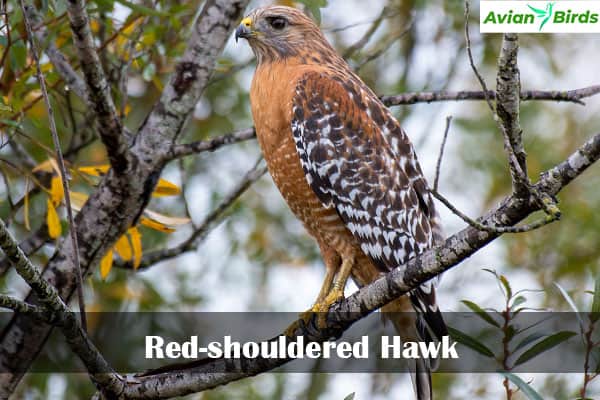
Key Characteristics
There are a few important things to know about Red-Shouldered Hawks:
- Wingspan: Adults are 37 to 42 inches wide, with females being bigger than males.
- Weight: Females weigh about 1.4 pounds, and males weigh 1.1 pounds.
- Coloration: They have a mix of chestnut and cream colors, helping them blend in with forests.
- Nesting behavior: They build nests in old trees, reuse them, and lay 2 to 3 eggs in early April.
The Red-Shouldered Hawk’s whistle is a sound you’ll hear in the woods. It helps us find them in their favorite places.
Where to Find Red-Shouldered Hawks
Red-shouldered hawks live in moist, old forests. They are common in the eastern U.S., including New York. Here are some good places to see them:
- Woodlands near lakes and streams.
- Parks and nature reserves in spring and summer.
- The Shawangunk Ridge is also a great place to see them.
Bird-watching in New York is exciting, especially during migrations. In spring, up to 500 Red-Shouldered Hawks can be seen in one day. They like to be in wooded areas, so we need to look up and listen for their calls.
| Characteristic | Details |
|---|---|
| Species Name | Buteo lineatus |
| Wingspan | 37 to 42 inches |
| Average Weight | Male: 1.1 lbs; Female: 1.4 lbs |
| Nesting | Builds nests in mature trees; reuses nests |
| Diet | Rodents, amphibians, reptiles, and birds |
3. Northern Harrier
The Northern Harrier, known as Circus hudsonius, is a special bird known for its unique hunting style. It can be seen flying over fields and wetlands.
Adult males have gray feathers and dark wing edges. Females are bigger and have broad wings. They have pale bellies with brown streaks.
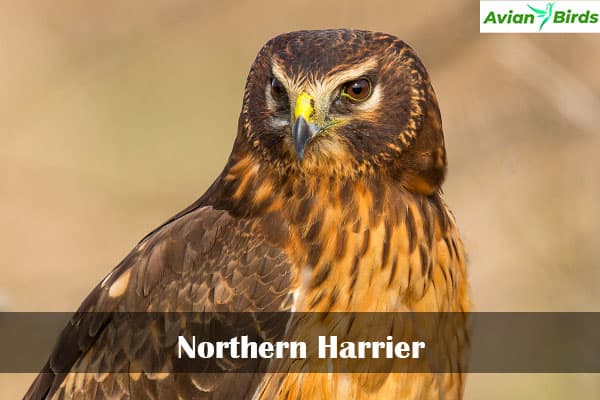
These hawks use their hearing and facial disk to find prey. They hunt small animals, birds, and insects. They surprise their prey by flying low.
Northern Harriers live in many places, from tundra to marshes. They nest on the ground, alone or in groups. This helps them hunt better.
Moreover, They have a wingspan of 3’2″ to 4′. They are bigger than Sharp-shinned Hawks but smaller than Red-tailed Hawks. They weigh 0.7 to 1.3 lbs.
But their numbers are going down because of lost habitats. We need to save open spaces for them. This helps keep their populations stable.
4. Cooper’s Hawk
The Cooper’s Hawk is a skilled hunter in cities. It has special Cooper’s Hawk traits that help it thrive. It mainly eats smaller birds, using bird feeders as hunting spots.
Its quick flying and silent approach make it great at hunting in cities.
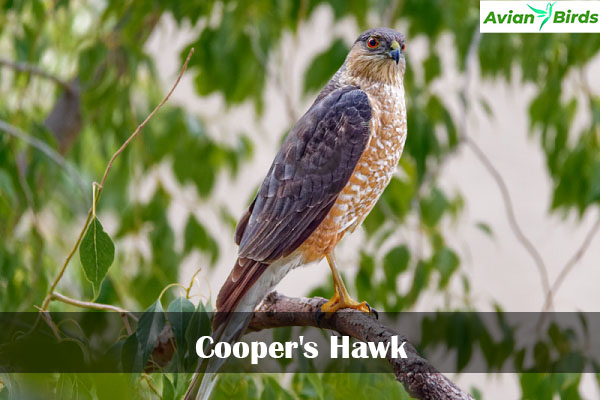
Appearance and Behavior
The Cooper’s Hawk has shiny blue-grey feathers. Males are smaller and act more shyly. They hunt different prey than females.
Females are bigger and like to eat medium-sized birds. This fits their hunting style.
Cooper’s Hawks catch birds by gripping them with their feet and squeezing them until the bird dies. About 23 percent of their skeletons show healed chest fractures, which shows how hard hunting is for them.
In cities, these hawks are becoming more common than in forests. They like places with lots of birds, especially near buildings. But eating too many doves can be bad for their young.
Despite past dangers from pesticides, Cooper’s Hawks are doing well again. Their numbers were growing by the 1980s. In winter, they go to places with lots of birds, showing they can live in cities.
| Characteristic | Males | Females |
|---|---|---|
| Size | Smaller | Larger |
| Behavior | Submissive | Dominant |
| Prey Preference | Smaller birds | Medium-sized birds |
| Hunting Technique | Grip with feet, squeezing | Grip with feet, squeezing |
| Population Trends | Urban commonality | Urban commonality |
Watching these birds, we see how well they adapt to cities. Their hunting skills make them stand out as urban hunters.
5. Sharp-Shinned Hawk
The Sharp-Shinned Hawk (Accipiter striatus) is the smallest raptor in North America. They have Sharp-Shinned Hawk features that make them interesting to watch. These birds live in deep forests and cities, especially when they migrate.

They are great at hunting in dense woods. They catch birds as small as an American Robin.
Birdwatchers love seeing Sharp-Shinned Hawks. The females are bigger than the males. They can be as big as a male Cooper’s Hawk.
Adult Sharp-Shinned Hawks have red-orange bars on their breasts. Immature hawks have brown and cream streaks. Both have dark bands on their tails.
Sharp-shinned hawks fly in a special way. They flap their wings fast and then glide a bit, which helps them surprise birds while hunting.
They nest in deep forests but hunt near forest edges. This is true during the nonbreeding months.
In New York, Sharp-Shinned Hawks are doing well. More of them are seen in surveys than before. This shows they are adapting and growing in their homes.
| Feature | Adult Sharp-Shinned Hawk | Immature Sharp-Shinned Hawk |
|---|---|---|
| Size | Small, long-tailed females larger than male | More robust with less defined features |
| Breast Coloration | Narrow horizontal red-orange bars | Coarse vertical streaks on white underparts |
| Tail Bands | Broad dark bands | Broad dark bands |
| Flight Style | Quick wing beats with short glides | Less agile but similar flight style |
Sharp-shinned hawks are increasing in number. They are a great example of how birds can thrive. Watching them in forests or during migration is amazing. They play a key role in our ecosystems.
Read More🐦Related Articles:
Conclusion
The hawks in New York are truly amazing. They are important for our environment. Each is unique, from the big Red-Tailed Hawk to the small Sharp-Shinned Hawk. They attract birdwatchers and nature lovers everywhere.
Stories of hawks like Pale Male and Octavia show how we can connect with wildlife. Their stories remind us of the need to protect them. Some hawks are doing well, but others need our help.
Let’s work together to understand and love these birds more. We should support birdwatching and protect their homes. This way, future generations can enjoy seeing hawks too.

